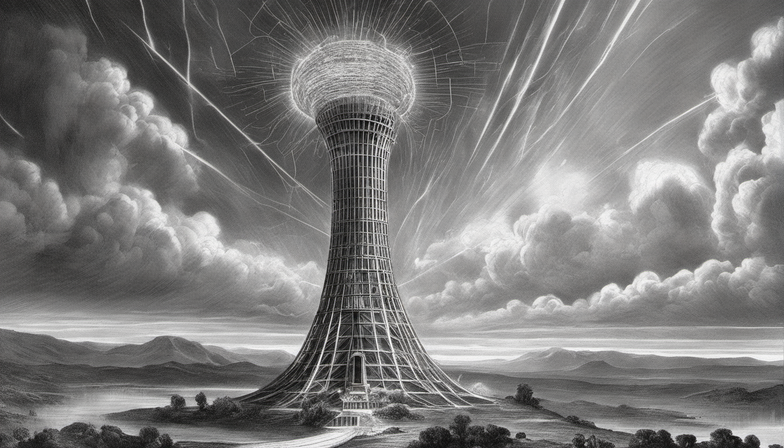Nikola Tesla, the brilliant Serbian-American inventor, electrical engineer, and futurist, was a man of extraordinary vision. Among his many groundbreaking contributions to the field of electrical engineering, Tesla harbored a dream of harnessing free currents from the atmosphere, a concept he referred to as “radiant energy” or “cosmic rays.” This ambitious vision aimed to revolutionize the way we generate and distribute electricity, promising a world where energy would be abundant, accessible, and free. At the heart of Tesla’s plan was the construction of a colossal tower near the Earth’s equator, connected to an intricate network of receivers dispersed globally. In this article, we will examine the details of Tesla’s plan to harvest free currents, exploring the scientific principles behind it and its potential implications for the future of energy.
The Genesis of Tesla’s Vision
Nikola Tesla’s pursuit of harnessing free currents stemmed from his deep fascination with electricity and his unyielding desire to improve the world’s technological landscape. Born in 1856 in the Austrian Empire (modern-day Croatia), Tesla immigrated to the United States in 1884 and eventually settled in New York City. Over the years, he worked with Thomas Edison, but their differing philosophies on electricity’s future led to a parting of ways. Tesla’s visions often bordered on the unorthodox, and his ideas about wireless transmission of power and communications were met with skepticism from his contemporaries.
Tesla’s revelation regarding the existence of abundant cosmic rays struck him like a bolt of lightning in 1899 while conducting experiments with radio waves at his Colorado Springs laboratory. The notion of tapping into an inexhaustible reservoir of energy without the need for traditional power sources ignited his imagination and drove him to devise a grand scheme that could potentially transform the world.
The Tower of Radiant Energy
At the core of Tesla’s plan was the construction of a mammoth tower, a structure that would serve as the pivotal node for capturing and transmitting radiant energy. This tower, often referred to as the “Tesla Tower” or the “Wardenclyffe Tower,” was envisioned to stand tall near the Earth’s equator. Tesla believed that locating the tower at this specific location would optimize its efficiency in capturing cosmic rays due to the Earth’s natural electromagnetic properties and its rotational motion.
The tower’s design featured a vertical metal mast, soaring hundreds of feet into the sky, with an extensive grounding system to establish a connection with the Earth. At its top, an expansive dome-like structure would house sophisticated receivers capable of harvesting cosmic energy from the atmosphere. Tesla’s concept relied on the principles of resonance and the Earth’s natural frequencies to enhance the collection of radiant energy.
The Global Network of Receivers
The Tesla Tower, standing majestically near the equator, would not act alone in the endeavor to capture cosmic rays. Tesla envisioned a vast network of receivers, spread across different continents and countries, to collectively harvest the energy transmitted by the tower. These receivers, designed to be smaller versions of the tower’s dome receivers, would convert the captured electric field into usable electricity through advanced rectifying circuits and transformers.
The distribution of receivers across the globe was of strategic significance. By having a wide geographical distribution, the network would ensure maximum coverage of energy capture, regardless of the time of day or local weather conditions. This redundancy was crucial to guarantee a continuous and uninterrupted supply of electricity to all regions within the network’s reach.
Scientific Principles Behind Tesla’s Vision
To comprehend Tesla’s vision for harvesting free currents, it is essential to understand the scientific principles that underpin his concept. Tesla drew upon several key ideas from the realm of electromagnetism and atmospheric physics:
Cosmic Rays and Ionosphere
Tesla’s understanding of cosmic rays was ahead of his time. Today, we know that cosmic rays are high-energy particles originating from various celestial sources, such as the sun and distant stars. As these cosmic rays enter the Earth’s atmosphere, they ionize the air, creating a conducting layer known as the ionosphere. Tesla believed that tapping into this ionized layer would allow him to capture the boundless radiant energy flowing through it.
Resonance and Standing Waves
Resonance played a pivotal role in Tesla’s plan. He intended to exploit the Earth’s natural frequencies to create standing waves between the tower and the ionosphere. By tuning the tower’s electrical properties to resonate with the natural frequencies of the Earth-ionosphere system, Tesla aimed to amplify the energy transfer and boost the efficiency of his wireless power transmission.
Wireless Power Transmission
The concept of wireless power transmission formed the backbone of Tesla’s vision. He had previously demonstrated wireless transmission of electricity over short distances, but the Wardenclyffe Tower represented his ambition to scale up the process dramatically. The tower’s massive structure and the network of receivers were the means by which Tesla intended to achieve long-range wireless power transmission.
Challenges and Criticisms
While Tesla’s vision for harvesting free currents was nothing short of revolutionary, it was not without its challenges and critics. Some of the most notable concerns raised include:
Economic Feasibility
One of the primary criticisms of Tesla’s plan was its economic feasibility. Critics argued that the construction and maintenance of such an extensive global network of receivers and a colossal tower would incur astronomical costs, far exceeding the benefits of free electricity.
Technological Limitations
During Tesla’s time, the required technology to realize his vision was far from being fully developed. Advanced materials, high-power rectifiers, and efficient transformers were crucial for efficient energy conversion and transmission, but they were beyond the technological reach of the early 20th century.
Environmental Impact
The potential environmental impact of harvesting radiant energy on such a large scale was a subject of concern. Some experts worried about possible disruptions to the Earth’s natural electromagnetic balance and the ionosphere’s delicate equilibrium.
Legacy and Modern Perspectives
Although Tesla’s grand plan for harvesting free currents never materialized during his lifetime, his ideas and inventions left a profound impact on the world of science and engineering. The Tesla Tower concept laid the groundwork for subsequent developments in wireless power transmission and resonant energy coupling.
In recent years, renewed interest in renewable energy and wireless power transmission has led some researchers to revisit Tesla’s vision. With advancements in materials science, power electronics, and wireless communication, some aspects of Tesla’s ideas have become more feasible than ever before.
Final Thoughts
Nikola Tesla’s vision for harvesting free currents was a testament to his innovative thinking and unwavering belief in the power of science to transform the world. While the construction of the Wardenclyffe Tower and the realization of his ambitious global energy network eluded him, his ideas continue to inspire generations of inventors, engineers, and futurists.
Tesla’s dream of abundant, accessible, and free energy remains a captivating prospect, driving humanity’s pursuit of sustainable and efficient energy sources. As we continue to explore new frontiers in science and technology, we may yet see elements of Tesla’s vision integrated into the fabric of our future energy landscape, ushering in a new era of clean and ubiquitous power for all.




